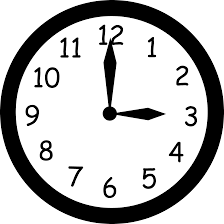Different 'times'?
What is the number of times the hour hand and the minute hand of a clock form a right angle with each other between 06:00 and 12:00 on the same day?

This section requires Javascript.
You are seeing this because something didn't load right. We suggest you, (a) try
refreshing the page, (b) enabling javascript if it is disabled on your browser and,
finally, (c)
loading the
non-javascript version of this page
. We're sorry about the hassle.
2 solutions
Let the angular velocity of the hour-hand and minute-hand be ω h and ω m ∘ / min respectively. Then ω h = 6 0 3 0 = 0 . 5 ∘ / min and ω m = 6 0 3 6 0 = 6 ∘ / min . Then the relative angular velocity, where the hour-hand is held stationary, is ω = ω m − ω h = 5 . 5 ∘ / min . Let time t = 0 min at 06:00 then 12:00 is when t = 6 × 6 0 = 3 6 0 min and the relative angle of the two hands, where hour-hand is fixed, be θ ( t ) = 5 . 5 t ∘ and θ ( 0 ) = 0 ∘ . Then the two hands are perpendicular when θ ( t ) = 9 0 ∘ , 2 7 0 ∘ , 4 5 0 ∘ ⋯ = 9 0 ∘ ( 2 n − 1 ) , where n is a positive integer. Then the number of times when the two hands are perpendicular is given by the largest n that satisfies the following inequality.
9 0 ( 2 n − 1 ) n ⟹ n ≤ θ ( 3 6 0 ) = 5 . 5 × 3 6 0 = 1 9 8 0 ≤ 2 9 0 1 9 8 0 + 1 = 1 1 . 5 = 1 1
The times the hour hand and the minute hand of a clock form a right angle with each other between 0 6 0 0 and 1 2 0 0 are approximately at 0 6 1 7 , 0 6 4 9 , 0 7 2 2 , 0 7 5 4 , 0 8 2 8 , 0 9 0 0 , 0 9 3 3 , 1 0 0 5 , 1 0 3 8 , 1 1 1 1 , 1 1 4 9 .
Note that this happens twice every hour, except between 0 8 0 0 and 1 0 0 0 when it happens only three times and not four times as expected.
This is because at 0 9 0 0 exactly the hands form a right angle. Thus between 0 6 0 0 and 1 2 0 0 it happens ( 6 × 2 ) − 1 = 1 1 times.